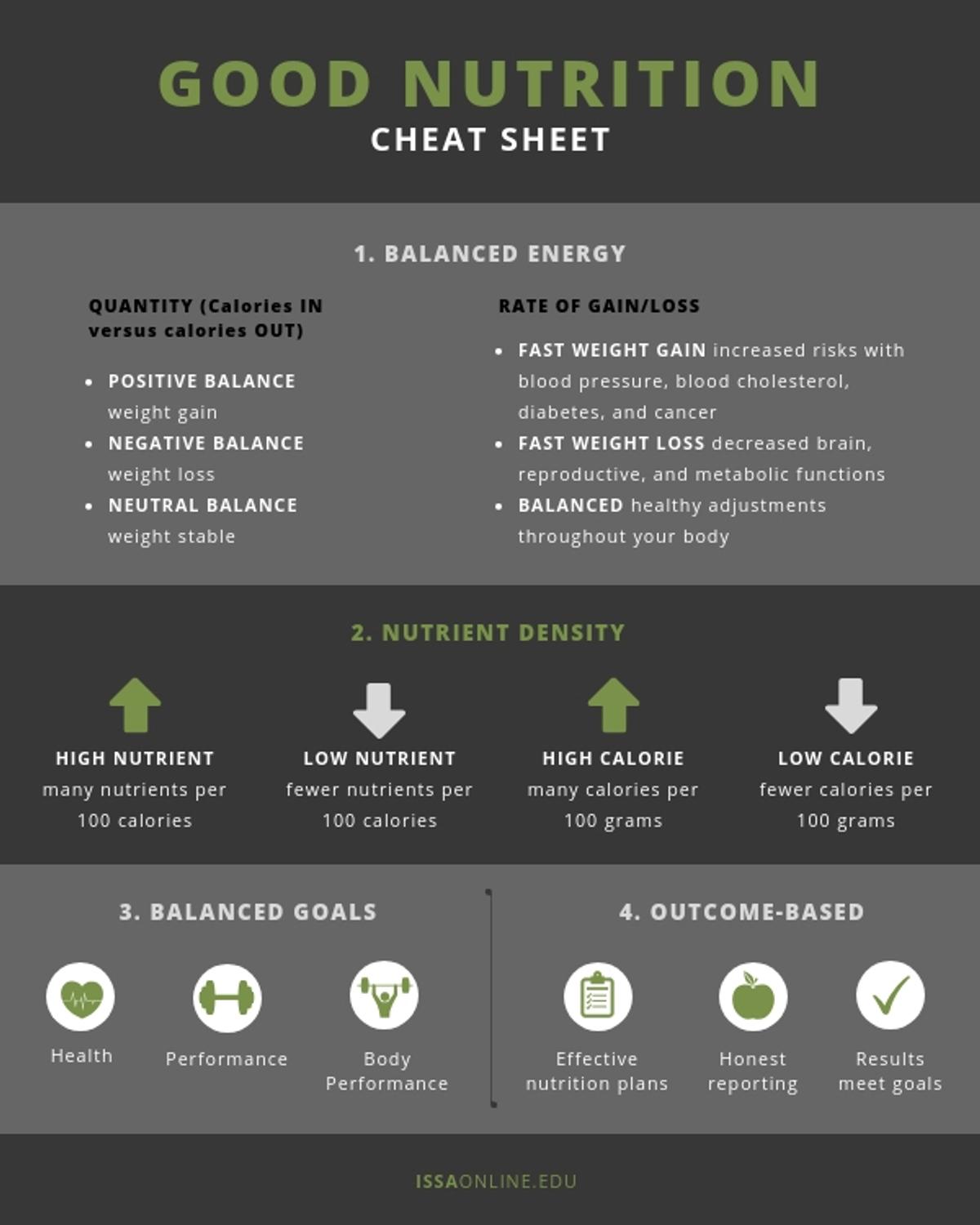
What's the Definition of Good Nutrition?
Reading Time: 3 minutes 55 seconds
BY: ISSA
DATE: 2018-09-21
Defining good nutrition isn't as simple as looking up a word in the dictionary. Your definition of good nutrition is rarely the same as your client's or even another trainer's definition. Is it about which foods to eat and which to avoid? What if you or your client is trying to gain muscle mass or lose a few extra pounds—does that change the definition of good nutrition?
Good nutrition is about more than just calories in. It's also about how your client expends them, what they're working toward, and what they achieve. Here, we'll explore the top four characteristics of a good nutrition plan:
Balanced energy
Nutrient density
Balanced goals
Honest outcomes
Balanced Energy for Good Nutrition
The relationship between incoming and outgoing energy seems straightforward: eat more calories to gain weight, eat fewer calories to lose weight, or find a balance of calories to maintain your weight. However, if you're looking to gain or lose weight, you'll also want to assess the rate at which you do so.
Consuming too many calories too fast leads to more than simple weight gain; it also raises your risk for:
High blood pressure
Diabetes
High blood cholesterol
Various cancers
And, as you can guess, losing weight too fast also poses a few risks:
Hormonal changes
Reduced metabolic functions
Lack of concentration
Reduced reproductive functions
A controlled change in nutrition, keeping the balance of energy from jumping to either extreme, allows the systems in your body to adjust naturally, from your hormones and metabolism to your mood and physical performance. Good nutrition plans use balanced energy to support healthy goals. Therefore, the approach to good nutrition means keeping the balance of energy in mind. This includes progressing the change slowly and in a way that works well for the body to change but also for the client to adopt new lifestyle changes.
Nutrient Density for Good Nutrition
What you eat is just as important as how much you eat—good nutrition will maximize the food you or your client consumes. Clients can get the most out of their food intake by understanding nutrient density: the number of nutrients in 100 calories of a food. For example, you'll get limited nutrients from a plain bagel with cream cheese that will pack on the calories, while foods like spinach and lean meats offer many more nutrients without an overwhelming number of calories. Clients often lose nutrient density by consuming too much of the wrong kinds of fats. You can help them learn more about the role fats play in their goals here. This is extra helpful for those clients wanting to lose fat while keeping good health. Remember, good nutrition shouldn't make clients work harder to meet their goals; in fact, it makes it easier to support a healthy body.
Following a diet that keeps a focus on nutrient density is important for good nutrition, regardless of the goals. You should help your clients in this area of focus by reviewing the nutrient density of different types of foods they typically eat. Then, together you can take a look at other food alternatives. At this point, have the client do a summary of the nutrient density for the different options. This will help get their buy in and increase their understanding for this key concept.
Balanced Goals for Good Nutrition
Now imagine that your next client is hyper-focused on losing weight. His goal is just to get the numbers on the scale to drop- today. He's not focusing on nutrient dense foods and he's not getting enough energy to support any functional performance. With this unbalanced approach, something is eventually going to give out.
Typically, clients will be seeking your help for one of the following goals:
Health
Performance
Body composition
Most clients will consider one of these their primary goal and hope your exercise and nutrition program accomplishes it as quick as possible. However, aggressively pursuing one of these goals only will offset the balance of good nutrition and potentially negatively affect the other areas. With the example of your weight loss client, if he only focuses on weight loss, he's going to have lower energy levels which will affect his performance and even his health. So, when you think about good nutrition, you need to encourage habits that will positively impact all three goals of health, performance, and body composition. This is a balanced goals approach to good nutrition.
Honest Outcomes from Good Nutrition
You know how to balance energy, you understand the importance of nutrient dense foods, and you set up goals that support your overall whole wellbeing, so what's left? The last step: developing honest outcomes. Long-term support of good nutrition is dependent on honest reporting to allow for realistic outcomes. You can have a great nutritional plan, but you won't get realistic results if the reporting isn't accurate. Review food tracking with your clients and encourage honest documentation. Honest tracking will lead to honest outcomes and a good nutrition plan will speak for itself as each goal is met.
As you've read, good nutrition is about more than just calories and eating vegetables. It's about eating to support a healthy life with balanced energy, nutrient dense foods, balanced goals, and committing to honest outcomes.
If you want to learn more about how you can help clients succeed with good nutrition, check out the ISSA's comprehensive course on Fitness Nutrition.

Now help your clients stay focused on good nutrition to support a healthy life.